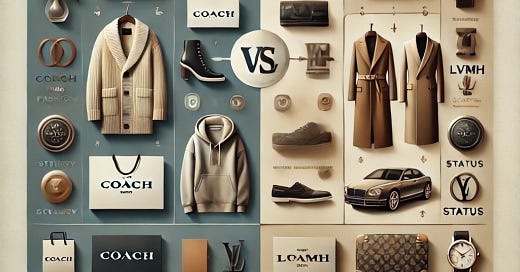I recently wrote an article on the luxury markets of China and India. During my research, I noticed a difference in my approach to purchasing Coach versus LVMH products. This distinction seems to hold true for the broader consumer base as well—Coach is positioned as a premium brand, whereas LVMH represents true luxury.
With this in mind, I believe it is important to introduce the concept of Luxury Consumer Segmentation (see below) for easier understanding of luxury markets. The following content was generated by ChatGPT. Since its explanation was clear and well-suited for a basic understanding, I have not modified it for this article. However, if you think any additions or refinements are necessary, please let me know.
Introduction
The luxury market is diverse, catering to consumers with varying levels of wealth, purchasing behavior, and brand loyalty. To better understand this landscape, luxury consumers are broadly classified into three categories: Premium, Luxury, and Ultra-Luxury. Each segment has distinct characteristics, preferences, and expectations from brands.
1. Premium Consumers
Definition:
Premium consumers purchase high-quality products that offer superior craftsmanship, innovation, and brand prestige but remain relatively accessible. These products are often viewed as aspirational yet attainable, making this segment the broadest in the luxury market.
Characteristics:
Price Sensitivity: Price-conscious but willing to pay a premium for superior quality.
Brand Loyalty: Moderate brand loyalty but open to exploring alternatives.
Frequency of Purchase: Regular purchases, often aligning with seasonal trends.
Demographics: Affluent middle-class professionals, young urban buyers, and aspirational consumers.
Key Categories: Fashion, beauty, electronics, automobiles, hospitality, and accessories.
Example Brands:
Fashion & Accessories: Michael Kors, Coach, Kate Spade
Beauty: Estée Lauder, MAC, Clinique
Automobiles: Audi A3, BMW 3 Series, Mercedes-Benz C-Class
Hospitality: Marriott, Hyatt Regency
Purchasing Behavior:
Rationale for Purchase: Value-driven decision-making with a focus on quality and status.
Shopping Channels: Online platforms, department stores, and brand outlets.
Marketing Approach: Digital campaigns, influencer collaborations, and exclusive membership programs.
2. Luxury Consumers
Definition:
Luxury consumers seek products that offer exclusivity, superior craftsmanship, and heritage branding. They prioritize experience, aesthetics, and status when making purchases.
Characteristics:
Price Sensitivity: Less price-sensitive; willing to invest in products with strong brand narratives.
Brand Loyalty: High loyalty, often sticking with specific luxury houses.
Frequency of Purchase: Less frequent but highly considered purchases.
Demographics: High-net-worth individuals (HNWIs), established professionals, and business owners.
Key Categories: High-end fashion, watches, automobiles, travel, and jewelry.
Example Brands:
Fashion & Accessories: Gucci, Louis Vuitton, Prada
Watches: Rolex, Omega, Cartier
Automobiles: Porsche, Tesla, Maserati
Hospitality: Ritz-Carlton, Four Seasons, Aman Resorts
Purchasing Behavior:
Rationale for Purchase: Prestige, self-expression, and superior craftsmanship.
Shopping Channels: Flagship stores, private boutiques, and brand-owned e-commerce.
Marketing Approach: Personalized services, celebrity endorsements, and limited-edition collections.
3. Ultra-Luxury Consumers
Definition:
Ultra-luxury consumers represent the pinnacle of the market, where exclusivity, rarity, and bespoke services define their experience. These individuals expect unique, one-of-a-kind offerings tailored to their specific preferences.
Characteristics:
Price Sensitivity: Not price-sensitive; purchases are driven by exclusivity and rarity.
Brand Loyalty: Extremely loyal to a handful of elite brands.
Frequency of Purchase: Rare, often buying collectibles and limited-edition items.
Demographics: Ultra-high-net-worth individuals (UHNWIs), celebrities, royalty, and billionaires.
Key Categories: Bespoke fashion, private jets, yachts, rare art, and luxury real estate.
Example Brands:
Fashion & Accessories: Hermès (Birkin bags), Chanel Haute Couture
Watches: Patek Philippe, Richard Mille, Audemars Piguet
Automobiles: Rolls-Royce, Bugatti, Ferrari
Hospitality: Private islands, luxury resorts, exclusive experiences (e.g., space travel with Virgin Galactic)
Purchasing Behavior:
Rationale for Purchase: Exclusivity, heritage, and investment value.
Shopping Channels: Private showrooms, by-appointment-only boutiques, invitation-only auctions.
Marketing Approach: White-glove concierge services, VIP experiences, and extreme personalization.
Market Trends and Insights
1. Digital Influence on Luxury Purchasing:
The rise of digital luxury commerce has made premium and luxury goods more accessible.
Social media influencers and brand ambassadors play a crucial role in shaping purchasing decisions.
2. Sustainability in Luxury:
Consumers are increasingly valuing sustainability and ethical sourcing in their luxury purchases.
Brands like Stella McCartney and Loro Piana are leading in sustainable luxury.
3. Emerging Markets and Growth Potential:
India, China, and the Middle East are becoming key players in the global luxury market.
Ultra-luxury experiences are seeing rapid growth in Asia and the Middle East.
4. Personalization & Experience-Driven Luxury:
From customized handbags to private fashion shows, personalization is redefining the luxury experience.
Brands offering experiential luxury, such as exclusive travel experiences, are gaining traction.
Conclusion
Understanding luxury consumers across these three tiers—Premium, Luxury, and Ultra-Luxury—is critical for brands looking to navigate and succeed in the evolving global market. While premium consumers seek aspirational yet attainable luxury, luxury buyers prioritize exclusivity and craftsmanship. At the highest level, ultra-luxury consumers demand bespoke, rare, and highly exclusive experiences.
As the global luxury market continues to evolve, brands must focus on digital innovation, personalization, and sustainability to cater to their target audience effectively.




